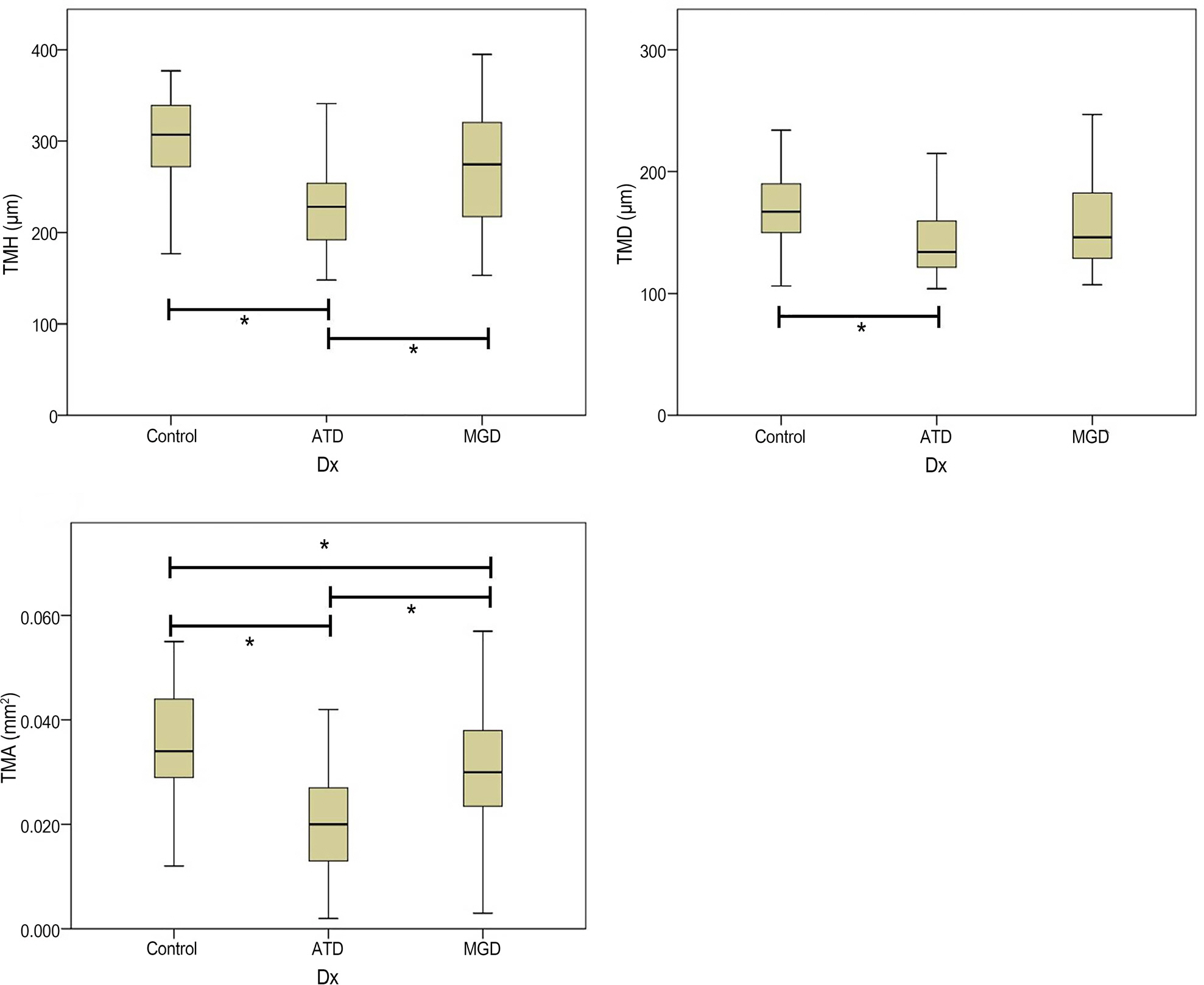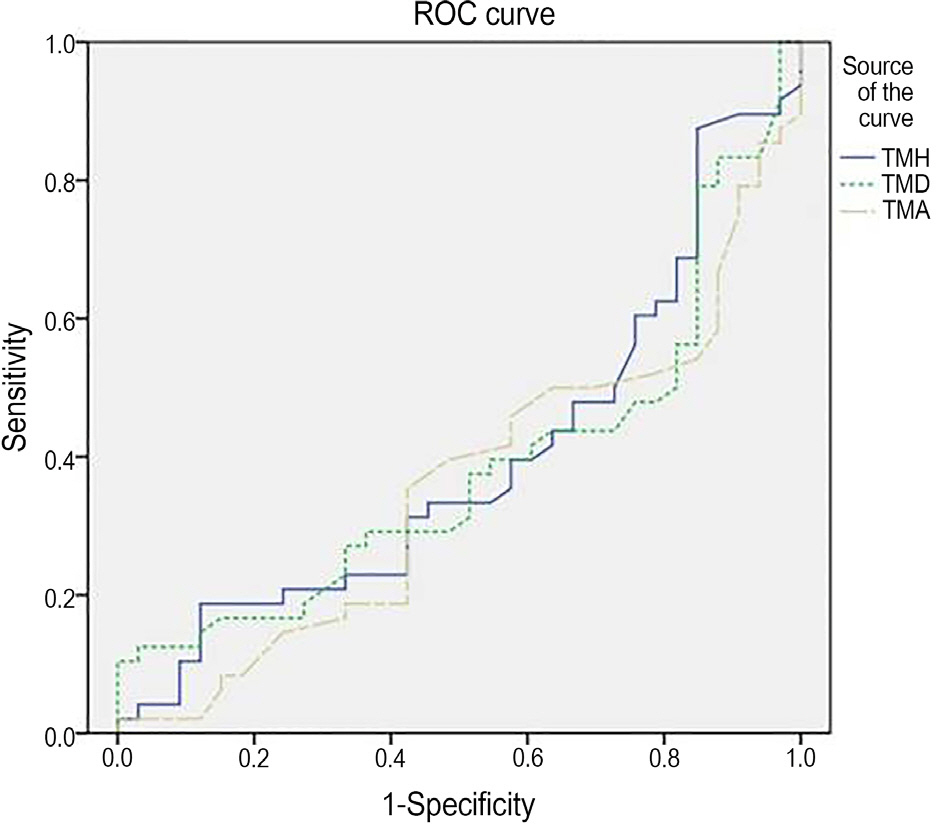J Korean Ophthalmol Soc.
2015 Nov;56(11):1684-1691. 10.3341/jkos.2015.56.11.1684.
Tear Meniscus Evaluation Using Optical Coherence Tomography in Meibomein Gland Dysfunction Patients
- Affiliations
-
- 1Department of Ophthalmology and Visual Science, Yeouido St. Mary's Hospital, College of Medicine, The Catholic University of Korea, Seoul, Korea.
- 2Department of Ophthalmology and Visual Science, St. Paul's Hospital, College of Medicine, The Catholic University of Korea2, Seoul, Korea. eyedoc@catholic.ac.kr
- KMID: 2214175
- DOI: http://doi.org/10.3341/jkos.2015.56.11.1684
Abstract
- PURPOSE
This study compared tear meniscus parameters between normal control, aqueous tear deficient dry eye, and meibomein gland dysfunction groups using Fourier-domain optical coherence tomography (FD-OCT).
METHODS
This study included 33 normal eyes, 79 aqueous tear-deficient dry eyes (ATD), and 48 meibomein gland dysfunction dry eyes (MGD). Following routine examination including Schirmer test, tear break-up time, corneal staining, and tear meniscus parameters such as tear meniscus height (TMH), tear meniscus depth (TMD), and tear meniscus area (TMA) were obtained using FD-OCT. The differences among groups were assessed.
RESULTS
The averages of TMH, TMD, and TMA were 295.58 +/- 58.36 microm, 166.67 +/- 30.43 microm, and 0.0360 +/- 0.01100 mm2 in normal eyes, respectively, 226.43 +/- 42.18 microm, 147.44 +/- 38.38 microm, and 0.0209 +/- 0.01015 mm2 in ATD, respectively, 272.81 +/- 64.21 microm, 159.37 +/- 44.05 microm, and 0.0295 +/- 0.01271 mm2 in MGD, respectively. Tear meniscus parameters were significantly lower in ATD. Tear meniscus parameters in MGD were higher than ATD and lower than normal eyes, but the TMA was the only statistically significant value.
CONCLUSIONS
Although tear meniscus parameters in MGD were higher than ATD, they could not be distinguished from normal eyes. Tear meniscus evaluation using FD-OCT could be a useful measurement system in classification and treatment choice for dry eye patients.
Figure
Cited by 2 articles
-
Clinical Features of Dry Eye in Thyroid-Associated Ophthalmopathy According to Disease Activity
Jun Young Ha, Won Choi, Kyung Chul Yoon
J Korean Ophthalmol Soc. 2016;57(7):1037-1043. doi: 10.3341/jkos.2016.57.7.1037.Correlation Analysis of Tear Film Lipid Layer Thickness and Ocular Surface Disease Index
Rae Young Kim, Kyung Sun Na, Yu Li Park, Hyun Seung Kim
J Korean Ophthalmol Soc. 2017;58(7):788-796. doi: 10.3341/jkos.2017.58.7.788.
Reference
-
References
1. The definition and classification of dry eye disease: report of the Definition and Classification Subcommittee of the International Dry Eye Workshop (2007). Ocul Surf. 2007; 5:75–92.2. Fukuda R, Usui T, Miyai T. . Tear meniscus evaluation by ante-rior segment swept-source optical coherence tomography. Am J Ophthalmol. 2013; 155:620–4. 624.e1-2.
Article3. Holly FJ. Physical chemistry of the normal and disordered tear film. Trans Ophthalmol Soc U K. 1985; 104:(Pt 4). 374–80.4. Yokoi N, Bron AJ, Tiffany JM. . Relationship between tear vol-ume and tear meniscus curvature. Arch Ophthalmol. 2004; 122:1265–9.
Article5. Mainstone JC, Bruce AS, Golding TR. Tear meniscus measure-ment in the diagnosis of dry eye. Curr Eye Res. 1996; 15:653–61.
Article6. Yokoi N, Bron AJ, Tiffany JM, Kinoshita S. Reflective meniscom-etry: a new field of dry eye assessment. Cornea. 2000; 19:(3 Suppl). S37–43.7. Altan-Yaycioglu R, Sizmaz S, Canan H, Coban-Karatas M. Optical coherence tomography for measuring the tear film meniscus: cor-relation with schirmer test and tear-film breakup time. Curr Eye Res. 2013; 38:736–42.
Article8. Wang J, Palakuru JR, Aquavella JV. Correlations among upper and lower tear menisci, noninvasive tear break-up time, and the Schirmer test. Am J Ophthalmol. 2008; 145:795–800.
Article9. Ibrahim OM, Dogru M, Takano Y. . Application of visante op-tical coherence tomography tear meniscus height measurement in the diagnosis of dry eye disease. Ophthalmology. 2010; 117:1923–9.
Article10. Nguyen P, Huang D, Li Y. . Correlation between optical coher-ence tomography-derived assessments of lower tear meniscus pa-rameters and clinical features of dry eye disease. Cornea. 2012; 31:680–5.
Article11. Tung CI, Perin AF, Gumus K, Pflugfelder SC. Tear meniscus di-mensions in tear dysfunction and their correlation with clinical parameters. Am J Ophthalmol. 2014; 157:301–10.e1.
Article12. Qiu X, Gong L, Sun X, Jin H. Age-related variations of human tear meniscus and diagnosis of dry eye with Fourier-domain anterior segment optical coherence tomography. Cornea. 2011; 30:543–9.
Article13. Sahai A, Malik P. Dry eye: prevalence and attributable risk factors in a hospital-based population. Indian J Ophthalmol. 2005; 53:87–91.
Article14. Calonge M, Diebold Y, Sáez V. . Impression cytology of the oc-ular surface: a review. Exp Eye Res. 2004; 78:457–72.
Article15. Nelson JD, Shimazaki J, Benitez-del-Castillo JM. . The inter-national workshop on meibomian gland dysfunction: report of the definition and classification subcommittee. Invest Ophthalmol Vis Sci. 2011; 52:1930–7.
Article16. Halberg GP, Berens C. Standardized Schirmer tear test kit. Am J Ophthalmol. 1961; 51:840–2.17. Clinch TE, Benedetto DA, Felberg NT, Laibson PR. Schirmer’s test. A closer look. Arch Ophthalmol. 1983; 101:1383–6.18. Maurice D. The Charles Prentice award lecture 1989: the physiol-ogy of tears. Optom Vis Sci. 1990; 67:391–9.
Article19. Pflugfelder SC, Tseng SC, Sanabria O. . Evaluation of sub-jective assessments and objective diagnostic tests for diagnosing tear-film disorders known to cause ocular irritation. Cornea 1998; 17. 38–56.
Article20. Kojima T, Ishida R, Dogru M. . A new noninvasive tear stabil-ity analysis system for the assessment of dry eyes. Invest Ophthal-mol Vis Sci. 2004; 45:1369–74.
Article21. Zhou S, Li Y, Lu AT. . Reproducibility of tear meniscus meas-urement by Fourier-domain optical coherence tomography: a pilot study. Ophthalmic Surg Lasers Imaging. 2009; 40:442–7.
Article22. Shen M, Wang J, Tao A. . Diurnal variation of upper and lower tear menisci. Am J Ophthalmol. 2008; 145:801–6.
Article23. Savini G, Barboni P, Zanini M. Tear meniscus evaluation by optical coherence tomography. Ophthalmic Surg Lasers Imaging. 2006; 37:112–8.
Article24. Canan H, Altan-Yaycioglu R, Ulas B. . Interexaminer reprodu-cibility of optical coherence tomography for measuring the tear film meniscus. Curr Eye Res. 2014; 39:1145–50.
Article25. Jung NY, Baek JW, Shin SJ, Chung SK. Tear meniscus evaluation using optical coherence tomography in dry eye patients. J Korean Ophthalmol Soc. 2015; 56:323–30.
Article
- Full Text Links
- Actions
-
Cited
- CITED
-
- Close
- Share
- Similar articles
-
- Tear Meniscus Evaluation Using Optical Coherence Tomography in Dry Eye Patients
- Changes in Area of Conjunctiva and Tear Meniscus Measured Using Anterior Segment Optical Coherence Tomography after Conjunctivochalasis Surgery
- Analysis of Tear Meniscus Change after Strabismus Surgery Using Optical Coherence Tomography
- Repeatability and Reproducibility of Tear Meniscus Evaluations Using Two Different Spectral Domain-optical Coherence Tomography
- Association between Dry Eye Questionnaires and Dry Eye Sign in Meibomian Gland Dysfunction





